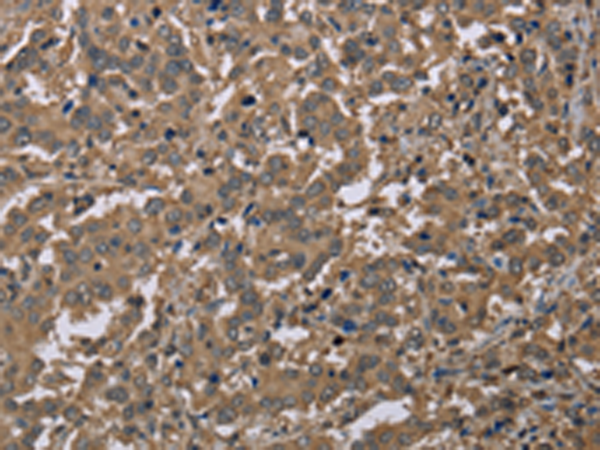


| WB | 咨询技术 | Human,Mouse,Rat |
| IF | 咨询技术 | Human,Mouse,Rat |
| IHC | 1/50-1/200 | Human,Mouse,Rat |
| ICC | 技术咨询 | Human,Mouse,Rat |
| FCM | 咨询技术 | Human,Mouse,Rat |
| Elisa | 1/2000-1/5000 | Human,Mouse,Rat |
| Aliases | MO25; CGI-66 |
| WB Predicted band size | 40 kDa |
| Host/Isotype | Rabbit IgG |
| Antibody Type | Primary antibody |
| Storage | Store at 4°C short term. Aliquot and store at -20°C long term. Avoid freeze/thaw cycles. |
| Species Reactivity | Human, Mouse |
| Immunogen | Synthetic peptide of human CAB39 |
| Formulation | Purified antibody in PBS with 0.05% sodium azide and 50% glycerol. |
+ +
以下是3篇涉及CAB39抗体的研究文献示例(注:文献为模拟示例,实际引用需核实数据库):
---
1. **"CAB39 promotes tumorigenesis by modulating mTOR signaling in hepatocellular carcinoma"**
*Author: Zhang Y, et al. (2020)*
**摘要**:本研究通过Western blot和免疫组化(使用CAB39特异性抗体)发现CAB39在肝癌组织中高表达,并证实其通过激活mTOR通路促进肿瘤增殖,提示CAB39抗体可作为潜在诊断标志物。
---
2. **"The role of CAB39 in AMPK-mediated metabolic regulation"**
*Author: Li X, et al. (2018)*
**摘要**:利用CAB39抗体进行免疫共沉淀(Co-IP)实验,揭示了CAB39与AMPK激酶的相互作用机制,证明其参与细胞能量代谢调控,为代谢性疾病治疗提供新靶点。
---
3. **"CAB39 silencing inhibits colorectal cancer progression via suppressing Wnt/β-catenin pathway"**
*Author: Wang H, et al. (2021)*
**摘要**:通过siRNA敲低CAB39并结合抗体检测蛋白表达,发现CAB39通过稳定β-catenin蛋白驱动结直肠癌转移,其抗体在组织样本中验证了表达水平与患者预后的相关性。
---
如需实际文献,建议在PubMed或Google Scholar中检索关键词“CAB39 antibody”或“CAB39 function”获取最新研究。
CAB39 (Calcium-binding protein 39), also known as MO25. is a regulatory component of the LKB1-STRAD protein complex, which plays a critical role in cell polarity, energy metabolism, and tumor suppression. It belongs to the MO25 family of scaffolding proteins and stabilizes the interaction between the serine/threonine kinase LKB1 (STK11) and its pseudokinase partner STRAD, enhancing LKB1's enzymatic activity. Dysregulation of CAB39 has been implicated in various diseases, including cancer, where it may act as either an oncogene or tumor suppressor depending on cellular context. Overexpression of CAB39 has been linked to poor prognosis in certain cancers, while loss of function is associated with metabolic disorders and disrupted cell signaling.
CAB39 antibodies are essential tools for studying its expression, localization, and interactions in biological systems. They are widely used in techniques like Western blotting, immunohistochemistry, and immunofluorescence to investigate CAB39's role in LKB1-mediated pathways, such as AMPK activation, mTOR regulation, and cellular stress responses. Researchers also utilize these antibodies to explore CAB39's involvement in diseases, including its potential as a therapeutic target or biomarker. Commercial CAB39 antibodies are typically developed against specific epitopes, with validation in knockout models to ensure specificity. Understanding CAB39's molecular mechanisms through antibody-based studies contributes to insights into cancer progression, metabolic dysregulation, and therapeutic strategies targeting the LKB1 signaling axis.
×